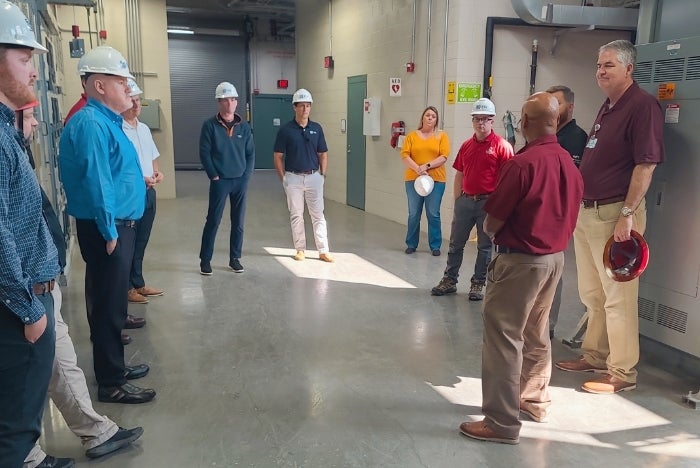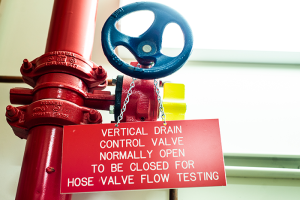Helping health care facilities do less with less

Facilities management teams rely on technology to help optimize staff resources and maintenance activities.
Image courtesy of FSI
No matter the person or one’s stage of life, at some point every American spends time in a hospital. Whether for preventive or corrective reasons, patients receiving care might take for granted that the heating, ventilating and air conditioning unit is working, the patient monitoring equipment operates seamlessly and the building is prepared for a disaster to ensure patient care is not interrupted.
Patients do not have to think about these things because thousands of facilities and biomedical maintenance professionals do their jobs every day. Dennis Ford, MHA, CHFM, CHC, FASHE, director of corporate facilities management support at North Carolina’s Atrium Health and the American Society for Health Care Engineering (ASHE) 2025 president-elect, succinctly relays this concept. “When we are successful in facilities operations, often nobody notices, as expectations of 100% uptime of building infrastructure systems is met,” Ford says.
While Ford and many others in the maintenance field do their job to avoid headlines about unsafe environments or regulatory noncompliance, these unsung heroes also rely on trusted technology partners to complete their work every day and to maintain a safe environment for patients. And as they navigate challenges created by labor shortages and generational transitions, aging equipment and natural disasters, FSI, is helping these health care maintenance teams adopt the philosophy of “less with less.”
Inspired by health care maintenance professionals
Founded in 2002 by Joe Serwinski, FSI initially launched as a data collection company, going on-site at hospitals to provide an accurate inventory of their physical assets. The process entails walking every square foot of a building, finding every asset and placing barcode labels on each one, recording essential information (manufacturer, make, model, location), and then double checking this work. Although it is a time-intensive task, maintaining an accurate asset inventory ensures that hospitals have a clear understanding of what exists in their environment.
The data collection business grew, and in 2006, Serwinski was approached by a customer with an interesting question: “Why collect all this information, organize it how the customer wants and then give it to another company?” This customer went on to ask, “Why not make your own software? We would use it.”
Seeing the opportunity, Serwinski moved quickly to develop a computerized maintenance management system (CMMS), which, at its most basic definition, is software for maintenance professionals to track work orders and assets, ensuring that both preventive maintenance and corrective maintenance is completed.
By 2020, FSI was serving more than 800 hospitals. But Serwinski recognized that they could do more, and in order to do so FSI needed more resources.
Less with less: preparing for technological and generational change
As evidenced by FSI’s origin story, it has always been a “by health care, for health care” operation —gaining inspiration from those it serves and incorporating the insights of those using its products into the software’s DNA. That focus continues today with the company’s vision to empower health care service professionals to maintain the safest environments and most efficient operations.
This commitment to health care helped develop the concept of “less with less.” In practice, doing less with less is all about enabling health system partners to do two things. “Doing less” means prioritizing work that will lead to the greatest benefit and eliminating work that has little to no impact or value. “With less” refers to making the most with the resources available to drive the best long-term outcomes efficiently and effectively. Thus, the two-pronged approach: “less with less.”
This principle is at the heart of the FSI mission: “Our strength lies in our innate customer understanding and our commitment to enabling them to do less with less. We work in partnership with each customer, guiding them throughout each collection, implementation and process improvement, saving them time, helping to simplify and reduce waste.”
This simple concept is not without its challenges. Starting with the second “less,” there’s no doubt that health care systems have had to become creative to combat the reality of constrained resources. In facilities maintenance and health care technology management specifically, this includes the critical and complex challenges of generation transition and change in the workforce. It is estimated that the average facilities and health care technology management technician is 55 years old, meaning these industries are searching for a new skilled talent pool as hardworking technicians retire, exacerbating the need to find solutions that can be done “with less” without compromising the quality of work.
The challenge of “doing less,” lies in the need for solutions to streamline and prioritize operational efficiency. As the facilities maintenance industry looks to adopt technology to automate workflows and reduce idle time, not all options look alike or offer the same level of tailor-made solutions built for the day-to-day realities of health care facilities and health care technology management requirements.
The secret ingredient: turning data into action
To rollout a successful “less with less” strategy, organizations must have data that provides insights to ensure they are focusing on the right type of work. While a CMMS stores the information customers need to make these data-driven decisions, a CMMS is oftentimes only as good as the data that resides within it.
Knowing exactly what assets a hospital has and where they are located is the most important first step in maintaining a facility. Many hospitals FSI work with, however, have lost track of this critical data, requiring cleanup efforts in order to get them on the “less with less” track.
To remedy this, FSI continues to offer in-house data collection services. By moving forward with a data collection, customers ensure that they know exactly what assets are in their system and where they are located. Furthermore, a data collection also provides a moment-in-time to standardize different fields, such as asset category, location data and nomenclature. This is especially important, as the ability to measure performance across an asset class relies on having standard naming conventions.
Once this data is in place, it’s essential for hospitals to find opportunities to take the “less with less” framework a step further by gathering insights from facilities data to make impactful decisions that will reduce wasted efforts, boost the actions that make the greatest impact and learn how to maximize the resources at hand.
FSI empowers customers to glean key insights by offering tools to visualize data in a meaningful way. Both customizable dashboards and business intelligence functionality allow customers to pre-calculate specific key performance indicator metrics, such as customer satisfaction and inspection, testing and maintenance performance, or to benchmark against health care regulatory standards from groups like ASHE. These components in FSI’s suite of solutions assist customers in arriving at insights, support decision-making and automate compliance reporting activities.
Putting “less with less” into practice
Taking the philosophy of “less with less” and making it a daily ritual requires the right tools to prioritize beneficial tasks and eliminate less impactful work while maximizing resources and streamlining operations.
As part of the “less with less” framework, in 2024 alone FSI has developed a new mobile application that reduces work order close time by more than 33%, reinvigorated dashboarding for easier management and data visualization, built new workflow automations to eliminate manual processes, deployed a new resource center and in-application training/guides, and released integrations with other facilities management products including PartsSource, Cynerio, Fluke OneQA, ServiceNow and CRx to eliminate multiple points of data entry.
The design of these products has been inspired by FSI’s customers and play a critical role in ensuring hospitals can save time and ensure their valuable team members are working on only the most impactful tasks. In brief, these products allow customers to do “less with less,” eliminating the work they don’t need to do with less resources.
While many CMMSs provide the necessary functionality to achieve compliance, asset management and operational efficiencies, FSI’s goal is to build a product that not only checks several fundamental boxes but also streamlines the unique workflows of a health care maintenance team — whether it’s integrating with other purpose-built tools a customer already relies on or adding new health care workflow-specific automation features that reduce clicks and increase the user-friendliness of FSI solutions.
Looking ahead: building a roadmap against an evolving landscape
With the generational transition and subsequent labor shortages, “less with less” is a strategy that more and more health care organizations will continue to adopt.
At FSI, this philosophy was developed based on firsthand experiences of health care maintenance professionals. This legacy continues as FSI leverages direct feedback to fine-tune products and empowers customers to do “less with less.”
Health care facilities maintenance and health care technology management teams should consider how they can adopt a “less with less” framework. Does the team have the tools to identify ways it could be doing less? Are the current solutions that are being used to maximize workforce and resources accomplishing the intended goal to do less?
As the health care maintenance industry encounters new challenges, FSI is committed to walk in lockstep with health care facilities teams, listening, testing and building, making “less with less” an achievable and intrinsic component to hospital operations. The highest compliment FSI’s hospital facilities customers give is that the company is more than a software vendor; FSI is a partner.
Zachary Seely, CEO of FSI, discusses the evolution of the market’s leading healthcare CMMS.




